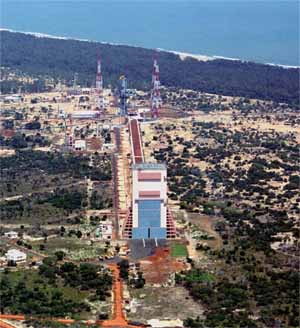Second Launch Pad
The Second Launch Pad (SLP) built at SDSC SHAR at Sriharikota is a state-of-the-art launch complex.
SLP is configured as a universal launch pad capable of accommodating all the launch vehicles of ISRO including the advanced launch vehicles to be built in the next decade and beyond (unlike dedicated launch pads elsewhere in the world mainly catering to a particular launch vehicle).
SLP uses the integrate-transfer-and-launch concept. The launch vehicle is integrated inside a permanent building called Vehicle Assembly Building (VAB). After checkout, it is transported on rails to the launch pad using a Mobile Launch Pedestal (MLP). The vehicle is then interfaced with the launch pedestal and fuel-filling and checkout operations carried out. The launch takes place after the final countdown. SLP helps to increase the launch frequency by reducing the turn around time for integration of the fully assembled vehicles.
SLP consists of the following major elements:
Vehicle Assembly Building (VAB): It is in this building that the vehicle integration is carried out on a Mobile Launch Pedestal (MLP) and then the vehicle transferred to Umbilical Tower for launch after carrying out the total checkout of the integrated vehicle. The 82 m tall VAB houses a 200 tonne and a 30 tonne capacity cranes for lifting vehicle stages. It has 20 horizontal sliding doors of varying sizes with the largest being 13 x 20 m. Six 14 x 6 m foldable and vertically repositionable platforms at different levels help vehicle integration and servicing. VAB is equipped with an elevator also.
Mobile Launch Pedestal (MLP): The 19.5 x 19.5 m MLP with a bogie system is used to transfer the integrated vehicle from VAB to the launch pad located at a distance of 1 km. With a height of 8.6 m, MLP weighs about 700 tonne and caters to both PSLV and GSLV requirements. It has a removable bogie system at the bottom, with a hydraulic system.
Umbilical Tower (UT): The 70 m tall, 10 x 10 m UT weighs about 980 tonne. The fully integrated vehicle on MLP, on its arrival on rails, is interfaced with UT with electrical, pneumatic and fluid filling lines. The final operations like fuel filling, gas charging and the vehicle checkout are carried out on UT. It has three platforms, which can be swung and also positioned/moved vertically to different levels. UT has an elevator and a 10 tonne tower crane at the top. It has a cryo arm for cryogenic fuel filling operations and monitoring till the last minute of launch operations.
Jet Deflector: The jet deflector system is used to move the hot gases, ejected from the launcher during lift-off, away from the launch pad so as to reduce the thermal and acoustic loads on the vehicle. The design and construction of jet deflector was one of the major engineering challenges. It has diaphragm wall construction with piles driven 45 m below ground, constructed for the first time on the east coast of India.
Lightning Protection Towers: In order to protect the launch vehicle from severe lightning when the vehicle is exposed for longer duration, lightning protection towers are erected around UT. There are four lightening protection towers of 120 m height around UT, which are interconnected through cables.
Propellant Storage and Servicing Facilities: Propellant storage and servicing facilities cater to the storage of about 1000 tonne of earth storable propellants (UDMH and N2O4), cryogenic propellants (liquid Oxygen and liquid Hydrogen), water, etc. A large gas storage and supply system to supply the required quantity of Helium for on-board systems and Nitrogen system for meeting the purging requirements is part of this facility. A water tank of 5 lakh litre capacity is also included.
Utilities: These include instrumentation and control systems, compressed air and fire fighting system, overhead tank, water treatment plant, electrical sub-station, air conditioning plant and safety system.[Text - ISRO]


